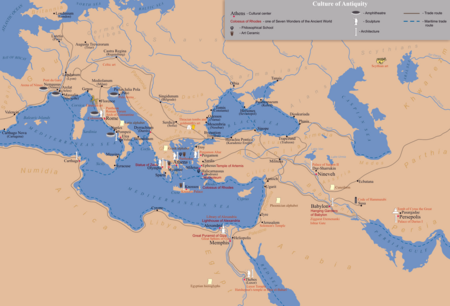Greco-Roman world
This article includes a improve this article by introducing more precise citations. (November 2015) ) |

The Greco-Roman civilization (/ˌɡriːkoʊˈroʊmən, ˌɡrɛkoʊ-/; also Greco-Roman culture or Greco-Latin culture; spelled Graeco-Roman in the Commonwealth), as understood by modern scholars and writers, includes the geographical regions and countries that culturally—and so historically—were directly and intimately influenced by the language, culture, government and religion of the Greeks and Romans. A better-known term is classical antiquity. In exact terms the area refers to the "Mediterranean world", the extensive tracts of land centered on the Mediterranean and Black Sea basins, the "swimming pool and spa" of the Greeks and the Romans, in which those peoples' cultural perceptions, ideas, and sensitivities became dominant in classical antiquity.
That process was aided by the universal adoption of Greek as the language of intellectual culture and commerce in the Eastern Mediterranean and of Latin as the language of public administration and of forensic advocacy, especially in the Western Mediterranean.
Greek and Latin were never the native languages of many or most of the rural peasants, who formed the great majority of the
Cores

Based on the above definition, the "cores" of the Greco-Roman world can be confidently stated to have been the
).Also included were Dacia (roughly modern-day Romania and Moldavia), Mauretania (modern-day Morocco, Western Algeria and Northern Mauritania), Jordan, Southern Syria and Egypt's Sinai Peninsula) and the Tauric Chersonesus (modern-day Crimea and the coast of Ukraine).
The Greco-Roman world had another "world" or empire to its east, the Persians, with which there was constant interaction: Xenophon, The Anabasis, the March Up Country, the Greco-Persian wars, the famous battles of Marathon and Salamis, the Greek tragedy The Persians by Aeschylus, Alexander the Great's defeat of the Persian emperor Darius III and conquest of the Persian empire, or the later Roman generals' difficulties with the Persian armies, such as Pompey the Great, and of Marcus Licinius Crassus (conqueror of the slave general Spartacus), who was defeated in the field by a Persian force and was beheaded by them.[1]
Culture
In the schools of art, philosophy, and rhetoric, the foundations of education were transmitted throughout the lands of Greek and Roman rule. Within its educated class, spanning all of the "Greco-Roman" eras, the testimony of literary borrowings and influences are overwhelming proofs of a mantle of mutual knowledge. For example, several hundred papyrus volumes found in a Roman villa at Herculaneum are in Greek. The lives of Cicero and Julius Caesar are examples of Romans who frequented schools in Greece.
The installation, both in Greek and Latin, of Augustus's monumental eulogy, the Res Gestae, exemplifies the official recognition of the dual vehicles for the common culture. The familiarity of figures from Roman legend and history in the Parallel Lives by Plutarch is one example of the extent to which "universal history" was then synonymous with the accomplishments of famous Latins and Hellenes. Most educated Romans were likely bilingual in Greek and Latin.
Architecture
Graeco-Roman architecture in the Roman world followed the principles and style that had been established by ancient Greece. That era's most representative building was the temple. Other prominent structures that represented that style included government buildings like the Roman Senate. The three primary styles of column design used in temples in classical Greece were Doric, Ionic, and Corinthian. Some examples of Doric architecture are the Parthenon and the Temple of Hephaestus in Athens, and the Erechtheum, next to the Parthenon, is Ionic.
Politics
This section may be confusing or unclear to readers. (December 2010) |
By AD 211, with
Religion
Greco-Roman mythology, sometimes called
From a historical point of view,
See also
- Classical Antiquity
- History of Western civilization before AD 500
- Classical mythology
- Greco-Roman mysteries
- Greek and Roman Egypt
- Hellenistic Greece
- Legacy of the Roman Empire
- List of Greco-Roman geographers
- Magic in the Greco-Roman world
References
- ^ Appian, The Civil Wars.
- ^ Entry on " mythology" in The Classical Tradition, edited by Anthony Grafton, Glenn W. Most, and Salvatore Settis (Harvard University Press, 2010), p. 614 and passim.
- ISBN 978-1-111-83169-1.)
{{cite book}}: CS1 maint: multiple names: authors list (link
Sources
- Sir William Smith (ed). Dictionary of Greek and Roman Geography. London: Spottiswoode and Co, 1873.
- Simon Hornblower and Antony Spawforth (ed). Oxford Classical Dictionary. Oxford University Press, 2003.
